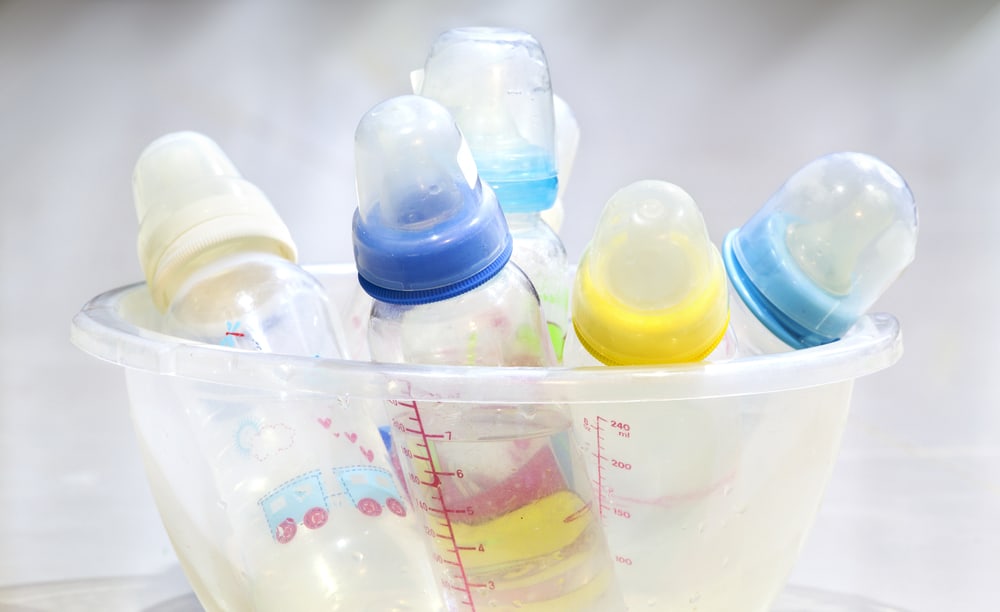Once mothers return to work, they’ll often try to transition their baby’s feeding from breast to bottle. While some mothers experience immediate success, others find feeding from a bottle to be incredibly difficult.
It’s not uncommon for some babies to refuse to take a bottle entirely, and instead of drinking up the milk, these babies may spit it straight back out. Some babies won’t even get any milk in their mouths because they’ll be trying to spit out the bottle nipple itself. These babies may easily become cranky and fussy.
If you’re having a difficult time figuring out what to do when your baby won’t take a bottle, take a look at some of our tips and tricks below. We’ve compiled some suggestions that could really help you make the transition.
3 Reasons Why Your Baby Is Refusing the Bottle (and Solutions for Them)
Nobody really knows why some babies refuse bottles or why some babies have difficulties transitioning from being breastfed to being bottle-fed. It happens by chance, and although it’s not something that a lot of parenting guides talk about, getting your baby to take a bottle may be one of the most difficult things that you’ll ever try to do.
Although it’s not known precisely why this is happening, we do have some ideas for what might be the cause. Below, we’ll look at 3 of the most common reasons why your baby might be refusing the bottle and, importantly, what you can do about it.
Reason #1: They Don’t Like the Feel of the Artificial Nipple
After being breastfed for weeks or months, some babies have become so accustomed to their mother’s nipples that they just don’t like the feel of the artificial nipple that’s on the bottle. It feels incredibly foreign to them, and they might have difficulties adjusting.
Some of these babies might adjust by themselves after some time; however, most of the time, these babies are going to need some extra help that only you can provide.
Solution #1: Switch up the Type of Nipple Used

Fortunately, there are many different types of bottle nipples available. If you are wondering what to do when your baby won’t take a bottle, try switching to a different baby bottle, making a note of the reaction that your baby has to each type of nipple. Some of the different nipples that you can choose from include:
- Traditional nipples. Traditional nipples are bell-shaped and have a narrow nipple tip. They provide a slower milk flow than naturally-shaped nipples. A slow flow can be greatly appreciated by many babies, as it helps them drink without gulping in too much air.
- Naturally-shaped nipples. Naturally-shaped nipples have wide nipples and have a similar feel to a mother’s breast. They’re actually a great option for babies that are transitioning from being breastfed to bottle-fed.
- Orthodontic nipples. Some studies show that traditional nipples may be associated with orthodontic issues. Orthodontic nipples have a bulb shape at the top and are flatter at the sides. This unique shape is designed to protect your baby’s teeth and gums. It may also be a more comfortable option for babies that are teething.
- Vented nipples. Vented nipples are designed for babies that easily get gassy and fussy. These nipples have a small opening at the side to prevent any vacuum buildup within the bottle. It may make it easier for some babies to bottle feed.
- Multi-flow nipples. Multi-flow nipples are ideal for thicker liquids and for a quicker flow, which some babies may prefer.
On top of establishing the type of nipple that your baby prefers, you’ll also need to figure out what nipple size they prefer. In general, the best nipple sizes are associated with your baby’s age. If the recommended nipple size doesn’t seem to work, go a size up or down. Different sizes may change the overall feel of the bottle nipple, as well as the flow of the milk.
Don’t Forget to Take Into Account the Type of Material
Other than the nipple type, you should also consider the type of material that the nipple is made of. You have two main options to choose between: silicone and latex. Both are excellent choices and have their unique advantages and disadvantages.
Silicone nipples tend to be less porous and firmer than latex nipples. They’re great for babies who need to chew while feeding and can retain their shape for a longer period of time. Plus, you won’t have to replace them as frequently, making them a more cost-effective option.
Latex nipples, on the other hand, better mimic the natural feel of a mother’s breast. They’re softer and more flexible; however, these nipples need to be replaced every 4 to 6 weeks. The longest they’ll hold up is about 3 months. After that, you’ll need to replace them. Because of this, latex nipples can be rather expensive.
Solution #2: Warm up the Nipple (and the Milk!)
Another reason that your baby may be refusing the bottle is if the milk and the nipple aren’t the right temperatures. If you’ve let the milk sit for too long, it may be too cool. Try to warm up the milk to one’s body temperature. You can also try warming the nipple under warm water to see whether that appeases your baby.
Fresh milk and frozen milk also taste different. You can try feeding your baby fresh breastmilk to see whether that makes a difference. Some babies are pickier and have a more refined palette; these babies are unlikely to drink frozen breastmilk.
Reason #2: They Associate Mom With Feeding and Don’t Want a Substitute
Babies who are particularly fond of breastfeeding aren’t going to be easily fooled with substitutes, and they’re not going to be happy with a bait-and-switch. If they’ve associated mom with feeding, they may be unwilling to take on any other substitute at all. But mothers can feel overworked and tired trying to accommodate their babies, so what can they do?
Solution #1: Get Someone Else to Feed Your Baby

Sometimes, a baby has such a strong association with mom and feeding that they simply cannot accept anything else. From the moment that their mothers embrace them, these babies will expect to be breastfed. A way to get around this is to change it up and have the dad or someone else feed the baby instead. This is also a great opportunity for family members, especially dad, to get some bonding time in!
Some parents have also found success if the family member, like the dad, removes their shirt and gives the baby some much-needed skin-on-skin contact! Skin-on-skin contact releases oxytocin, which further helps both parties to bond.
Solution #2: Wrap the Bottle in Mom’s Shirt
This one might sound weird, but it’s surprisingly effective. Try wrapping the feeding bottle in one of mom’s shirts or towels so that the bottle smells like her. It might help your baby become keener on taking up the bottle.
Solution #3: Let Your Baby Play With the Nipple Like a Pacifier
Instead of forcing your baby to see the bottle nipple as a source of food, try getting them accustomed to it first by treating it like a toy. Let them chew on and play with the bottle nipple as if it was a pacifier. The key is to get them to associate fun with the bottle nipple.
Later on, they’ll be so accustomed to sucking and playing with the nipple that they’ll be less likely to reject a bottle during feeding times. Keep in mind that it can take some time for a baby to become accustomed to the bottle nipple. Due to this reason, you might want to let your baby play with a bottle nipple while they’re still breastfeeding. It may help lead to an easier transition.
Solution #4: Dip the Bottle Nipple in Breastmilk
If your baby has strongly associated mom with feeding, they may not fully understand why you’re putting a bottle in their face. You can encourage your baby to latch onto the bottle nipple by dipping it in some breast milk.
Reason #3: They Have a Negative Experience With the Bottle
This is honestly the least likely scenario; however, you should consider it if your child didn’t have a problem bottle feeding at all and then suddenly decided that they didn’t like it. Sudden aversion to the bottle can signal a negative experience. Turning a negative experience back into a positive one can be rather difficult.
A negative experience can be anything from throwing up once when feeding from a bottle or taking a bottle from someone who doesn’t know how to feed them properly. You really can never tell what turned your baby off from feeding from a bottle. Due to this, finding a solution for this cause can get rather complicated. Here’s what we suggest.
Solution #1: Try Feeding With Something Other Than a Bottle
Some babies simply don’t like the bottle. In these situations, you might want to try feeding your baby with something else, like a sippy cup or a spoon.
Make sure that you hold your baby steadily in an upright position before bringing the milk to their mouth. Let the baby feed at their own pace. Don’t rush this process, as it could cause your baby to choke.
Solution #2: Praise Your Baby Every Time
Verbal praise can encourage a baby to take to the bottle once again. Although your baby may not necessarily understand what you’re saying, they’ll understand your tone and body language.
Every time that you place a bottle near your baby’s mouth, encourage them. If they suck on the nipple, shower them with praise! Let them know just how proud you are of their accomplishment.
Solution #3: Wait Until Your Baby Is Half-Asleep
If your baby is half-asleep, they’re likely not going to remember the interaction or the fact that they had a negative experience with the bottle. They’re just going to latch on and start drinking.
You can try dream feeding, which is when you feed your baby in the middle of the night without them even knowing. You can also try feeding a very sleepy baby that’s half-asleep to see whether they’re still resisting the bottle. Some babies will take a bottle without realizing it at all.
Other Tips That Might Help
While you’re trying to figure out what to do when your baby won’t take a bottle, you’ll probably also come across many other tips and tricks that are worth a try. We’ve found that the following tips have helped many other mothers who are struggling with the same issue.
Try a Different Position
If your baby is in an uncomfortable position, they are less likely to latch onto the nipple. Different babies prefer different feeding positions. You can try holding your baby in a different way to see if that helps. For example, some parents might prop their babies on their legs during feeding time.
Switch Sides
Another fun thing that you can try is switching sides. A different perspective might encourage your baby to latch onto the bottle even if they were not interested in it before. Try the side that the baby prefers the most when breastfeeding. If that doesn’t work, switch to the other side.
Limit Distractions
If your baby is constantly distracted during feeding time, they may not be as accepting of the bottle. They might want to explore the new stimuli that are present. For example, if you have the TV on, your baby might be too focused on what’s happening on the screen.
Feed your baby in a quiet room without any distractions, like a TV or radio. You might even want to rock or sway your baby for a couple of minutes in a quiet room, so they can relax. If you have other children, have them leave the room. Also, consider dimming the lights to create a serene and peaceful environment.
Introduce the Mouth to the Bottle
Instead of bringing the bottle to your baby’s mouth, offer the bottle to your baby and let them take the lead.
Bring the nipple to the baby’s nose and slowly stroke downwards or bring the bottle up to the baby’s mouth and rub it along their gums and inner cheeks. You might even consider just tickling their upper lip or cheek.
Babies naturally have a rooting reflex, which will cause them to turn to the side that’s being stroked and to start sucking. This reflex can come in quite handy if you don’t know what to do when your baby won’t take a bottle. Keep in mind that this reflex only lasts for the first 4 months of life, though.
Check for Medical Issues
Some babies will refuse to take a bottle for medical reasons. They might not be feeling well. Consider taking your baby to the doctor for a checkup just to make sure that there isn’t anything wrong. If your baby has been incredibly fussy recently, they may have the flu or some other type of gastrointestinal issue. Almost all medical issues can cause a baby to refuse to take a bottle.
Be Patient
Last but not least, practice patience. If you’re stressed out and unhappy, your baby will also be stressed out and unhappy. Negative emotions can cause your baby to shy away from the bottle or from getting bottle-fed.
Try not to get frustrated even if your baby is not interested in bottle feeding at all. Don’t raise your voice at them or show any signs of frustration. It won’t help anyone and is likely to make the situation even worse.
Keep Calm and Carry On
Studies have found that some babies will never accept a bottle. If you are struggling to get your baby to accept the bottle, just know that it’s not your fault or your baby’s!
We know it can be difficult to figure out what to do when your baby won’t take a bottle. It’s not an easy mystery to solve, especially since babies can’t tell you why they’re acting a certain way. The key to getting your baby to take up a bottle may be persistence. If you fail to get your baby to bottle feed, try and try again. Don’t give up. Many parents have had to try many times before getting their babies to latch onto the bottle nipple or show any interest in it. You may wish to check out our complete guide to the best bottles for breastfed babies.
If all else fails, you can always speak to a professional, like a lactation consultant, to see whether they can offer any additional insight. They might be able to teach you new techniques and skills that could help your situation.
